In this post I have explained the fundamental tips and theories which may be useful for the newcomers while designing or dealing with basic inverter concepts. I have explained more.
What's an Inverter
It's a device which converts or inverts a low voltage, high DC potential into a low current high alternating voltage such as from a 12V automotive battery source to 220V AC output.
Basic Principle behind the above Conversion
The basic principle behind converting a low voltage DC to a high voltage AC is to use the stored high current inside a DC source (normally a battery) and step it up to a high voltage AC.
This is basically achieved by using an inductor, which is primarily a transformer having two sets of winding namely primary (input) and secondary (output).
The primary winding is meant for receiving the direct high current input while the secondary is for inverting this input into the corresponding high voltage low current alternating output.
What is Alternating Voltage or Current
By alternating voltage we mean a voltage which switches its polarity from positive to negative and vice versa many times a second depending upon the set frequency at the input of the transformer.
Generally this frequency is a 50Hz or 60 Hz depending upon the particular country's utility specs.
An artificially generated frequency is used at the above rates for feeding the output stages which may consist of power transistors or mosfets or GBTs integrated with the power transformer.
The power devices respond to the fed pulses and drive the connected transformer winding with the corresponding frequency at the given battery current and voltage.
The above action induces an equivalent high voltage across the transformer secondary winding which ultimately outputs the required 220V or 120V AC.
A Simple Manual Simulation
The following manual simulation shows the basic operating principle of a center tap transformer based push pull inverter circuit.
When the primary winding is switched alternately with a battery current, an equivalent amount of voltage and current is induced across the secondary winding through flyback mode, which illuminates the connected bulb.
In a circuit operated inverters the same operation is implemented but through power devices and an oscillator circuit which switches the winding at a much faster pace, usually at the rate of 50Hz or 60Hz.
Thus, in an inverter the same action due to fast switching would cause the load to appear always ON, although in reality the load would be switched ON/OFF at 50Hz or 60Hz rate.
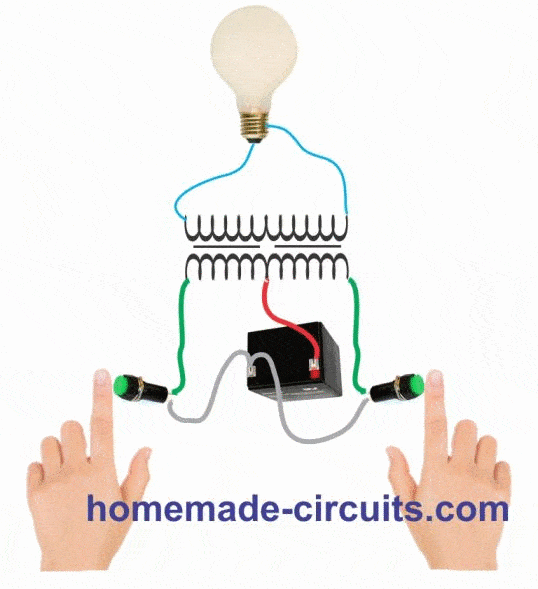
How the Transformer Converts a given Input
As discussed above, the transformer usually will have two winding, one primary and the other secondary.
The two winding react in such a way that a when a switching current is applied at the primary winding would cause a proportionately relevant power to be transferred across the secondary winding through electromagnetic induction.
Therefore suppose, if the primary is rated at 12V and the secondary at 220V, an oscillating or pulsating 12V DC input to the primary side would induce and generate a 220V AC across the secondary terminals.
However, the input to the primary cannot be a direct current, meaning though the source may be a DC, it must be applied in a pulsed form or intermittently across the primary, or in the form of a frequency at the specified level, we have discussed this in the previous section.
This is required so that the inherent attributes of an inductor can be implemented, according to which an inductor restricts a fluctuating current and tries to balance it by throwing an equivalent current into the system during the absence of the input pulse, also known as flyback phenomenon.
Therefore when the DC is applied, the primary stores this current, and when the DC is disconnected from the winding, allows the winding to kick back the stored current across its terminals.
However since the terminals are disconnected, this back emf gets induced into the secondary winding, constituting the required AC across the secondary output terminals.
The above explanation thus shows that a pulser circuit or more simply put, an oscillator circuit becomes imperative while designing an inverter.
Fundamental Circuit Stages of an Inverter
To build a basic functional inverter with reasonably good performance, you will need the following basic elements:
- Transformer
- Power Devices, such as N-channel MOSFETs or NPN Biploar Power Transistors
- Lead Acid Battery
Block Diagram
Here's the block diagram which illustrates how to implement the above elements with a simple configuration (center tap push-pull).

How to Design an Oscillator Circuit for an Inverter
An oscillator circuit is the crucial circuit stage in any inverter, as this stage becomes responsible for switching the Dc into the primary winding of the transformer.
An oscillator stage is perhaps the simplest part in an inverter circuit. It's basically an astable multivibrator configuration which can be made through many different ways.
You can use NAND gates, NOR gates, devices with built-in oscillators such as IC 4060, IC LM567 or just utterly a 555 IC. Another option is the use of transistors and capacitors in standard astable mode.
The following images show the different oscillator configurations which can be effectively employed for achieving the basic oscillations for any proposed inverter design.
In the following diagrams we see a few popular oscillator circuit designs, the outputs are square wave which are actually positive pulses, the high square blocks indicate positive potentials, the height of the square blocks indicate the voltage level, which is normally equal to the applied supply voltage to the IC, and the width of the square blocks indicate the time span for which this voltage stays alive.
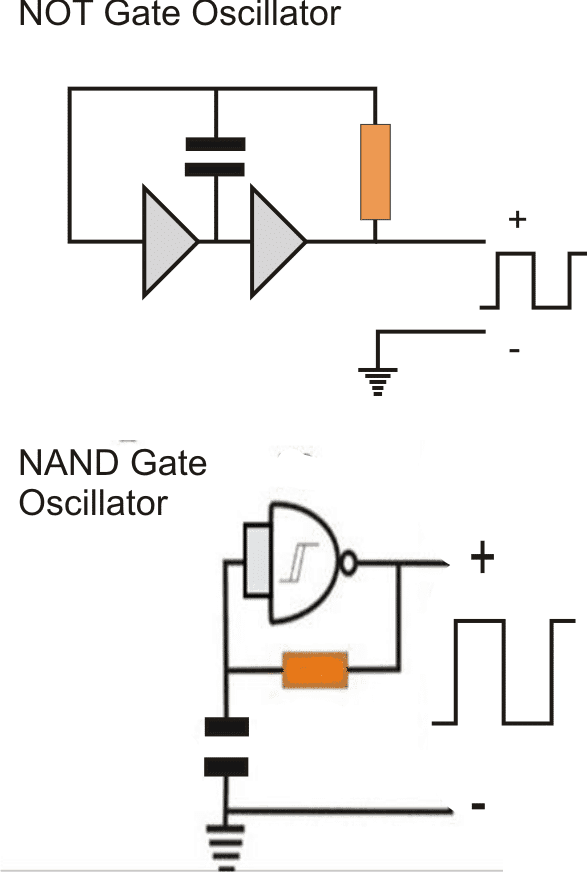


The Role of an Oscillator in an Inverter Circuit
As discussed in the previous section, an oscillator stage is required for generating basic voltage pulses for feeding the subsequent power stages.
However the pulses from these stages can be too low with their current outputs, and therefore it cannot be fed directly to the transformer or to the power transistors in the output stage.
In order to push the oscillation current to the required levels, an intermediate driver stage is normally employed, which might consist of a couple of high gain medium power transistors or even something more complex.
However today with the advent of sophisticated mosfets, a driver stage may be completely eliminated.
This is because mosfets are voltage dependent devices and does not rely on current magnitudes for operating.
With the presence of a potential above 5V across their gate and source, most mosfets would saturate and conduct fully across their drain and source, even if the current is as low as 1mA
This makes conditions hugely suitable, and easy for applying them for inverter applications.
We can see that in the above oscillator circuits, the output is a single source, however in all inverter topologies we require an alternately or oppositely polarized pulsing outputs from two sources. This can be simply achieved by adding an inverter gate stage (for inverting the voltage) to the existing output from the oscillators, see the figures below.
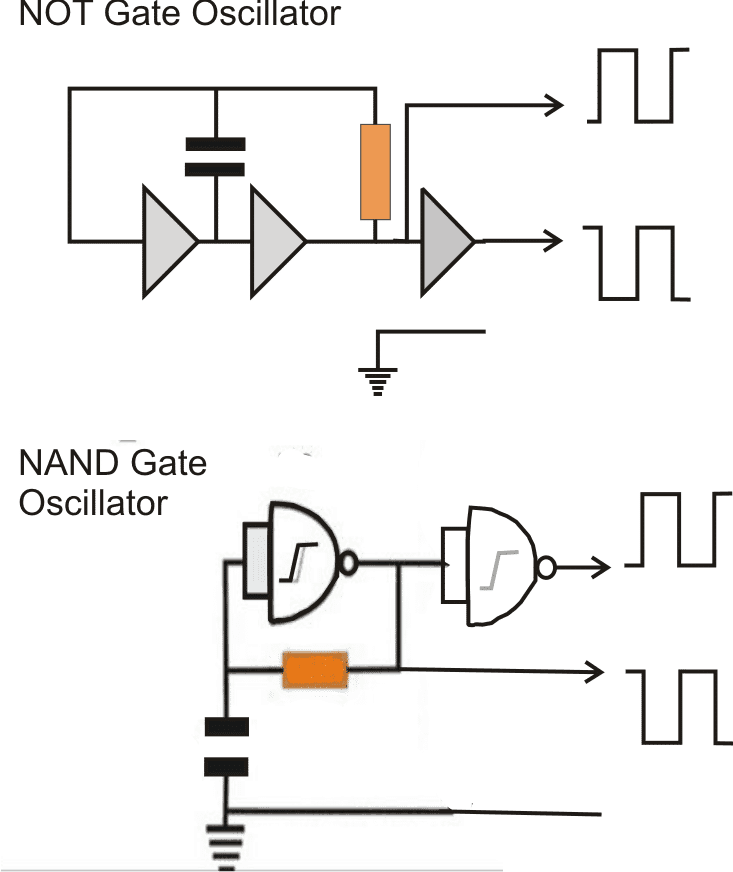

Configuring Oscillator Stage to Design Small Inverter Circuits
Now let's try to understand the easy methods through which the the above explained with oscillator stages can be attached with a power stage for creating effective inverter designs quickly.
Designing an Inverter Circuit using NOT Gate Oscillator
The following figure shows how a small inverter can be configured using a NOT gate oscillator such as from the IC 4049.

Here basically N1/N2 forms the oscillator stage which create the required 50Hz or 60Hz clocks or oscillations required for the inverter operation. N3 is used for inverting these clocks because we need to apply oppositely polarized clocks for the power transformer stage.
However we can also see N4, N5 N6 gates, which are configured across the input line and output line of N3.
Actually N4, N5, N6 are simply included for accommodating the 3 extra gates available inside the IC 4049, otherwise only the first N1, N2, N3 could be alone used for the operations, without any issues.
The 3 extra gates act like buffers and also make sure that these gates are not left unconnected, which can otherwise create adverse effect on the IC in the long run.
The oppositely polarized clocks across the outputs of N4, and N5/N6 are applied to the bases of power BJT stage using TIP142 power BJTs, which are capable of handling a good 10 amp current. The transformer can be seen configured across the collectors of the BJTs.
You will find that no intermediate amplifier or driver stages are used in the above design because the TIP142 itself has an internal BJT Darlington stage for the required in-built amplification and therefore are able to comfortably amplify the low current clocks from the NOT gates into high current oscillations across the connected transformer winding.
More IC 4049 inverter designs can found below:
Homemade 2000 VA Power Inverter Circuit
Simplest Uninterrupted Power Supply (UPS) Circuit
Designing an Inverter Circuit using Schmidt Trigger NAND gate Oscillator
The following figure shows how an oscillator circuit using IC 4093 can be integrated with a similar BJT power stage for creating a useful inverter design.

The figure demonstrates a small inverter design using IC 4093 Schmidt trigger NAND gates. Quite identically here too the N4 could have been avoided and the BJT bases could have been directly connected across the inputs and the outputs N3. But again, N4 is included to accommodate the one extra gate inside the IC 4093 and to ensure that its input pin not left unconnected.
More similar IC 4093 Inverter designs can be referred from the following links:
Best Modified Inverter Circuits
How to Make a Solar Inverter Circuit
How to Build a 400 Watt High Power Inverter Circuit with Built in Charger
How to Design an UPS Circuit – Tutorial
Pinout diagrams for the IC 4093 and IC 4049
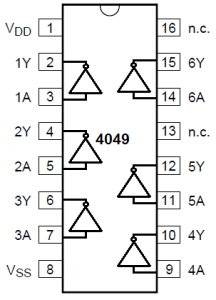
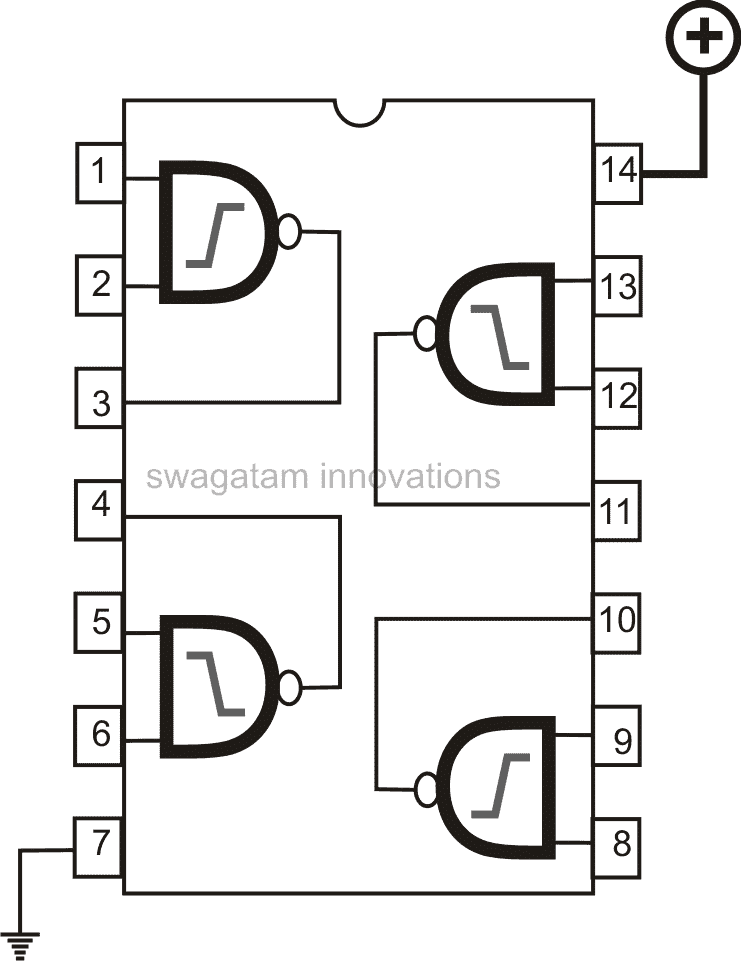
NOTE: The Vcc, and Vss supply pins of the IC are not shown in the inverter diagrams, these must be appropriately connected with the 12V battery supply, for 12V inverters. For higher voltage inverters this supply must be appropriately stepped down to 12V for the IC supply pins.
Designing a Mini Inverter Circuit using IC 555 Oscillator
From the above examples, it becomes quite evident that the most basic forms of inverters could be designed by simply coupling a BJT + transformer power stage with an oscillator stage.
Following the same principle an IC 555 oscillator can be also used for designing a small inverter as shown below:
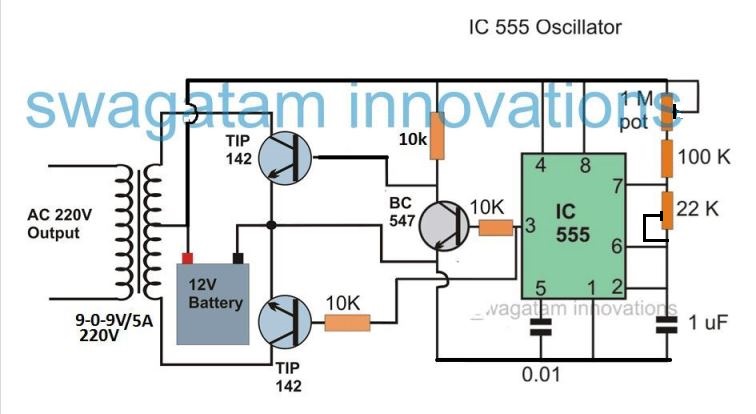
The above circuit is self explanatory, and perhaps does not require any further explanation.
More such IC 555 inverter circuit can be found below:
Simple IC 555 Inverter Circuit
Understanding Inverter Topologies (How to Configure the Output Stage)
In the above sections I have explained about the oscillator stages, and also the fact that the pulsed voltage from the oscillator goes straight to the preceding power output stage.
There are primarily three ways through which an output stage of an inverter may be designed.
By Using a:
- Push Pull Stage (with Center Tap Transformer) as explained in the above examples
- Push Pull Half-Bridge Stage
- Push Pull Full-Bridge or H-Bridge Stage
The push pull stage using a center tap transformer is the most popular design because it involves simpler implementations and produces guaranteed results.
However it requires bulkier transformers and output is lower in efficiency.
A couple of inverter designs can be seen below which employs a center tap transformer:

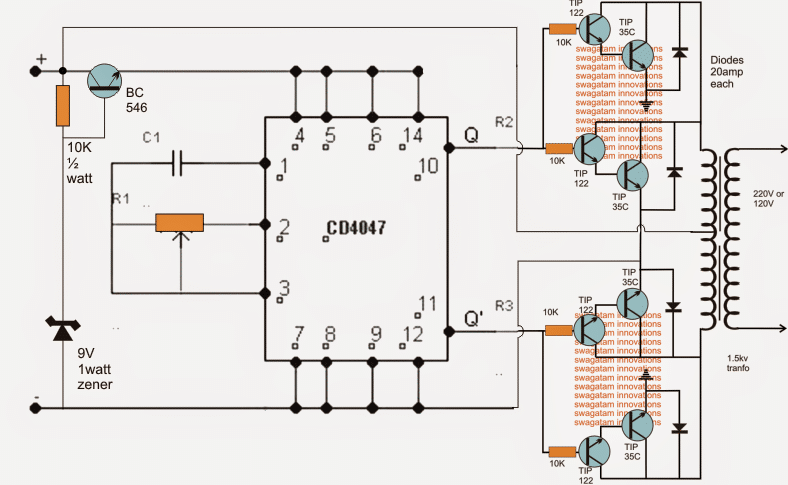
In this configuration, basically a center-tap transformer is used with its outer taps connected to the hot ends of the output devices (transistors or mosfets) while the center tap either goes to the negative of the battery or to the positive of the battery depending upon the type of devices used (N type or P type).
Half-Bridge Topology
A half bridge stage does not make use of a center tap transformer.
A half bridge configuration is better than a center tap push pull type of circuit in terms of compactness and efficiency, however it requires large value capacitors for implementing the above functions.

A full bridge or an H-bridge inverter is similar to a half bridge network since it also incorporates an ordinary two tap transformer and does not require a center tap transformer.
The only difference being the elimination of the capacitors and the inclusion of two more power devices.
Full-Bridge Topology
A full bridge inverter circuit consists of four transistors or mosfets arranged in a configuration resembling the letter "H".
All the four devices may be N channel type or with two N channel and two P channel depending upon the external driver oscillator stage that's being used.
Just like a half bridge, a full bridge also requires separate, isolated alternately oscillating outputs for triggering the devices.
The result is the same, the connected transformer primary is subjected to a reverse forward kind of switching of the battery current through it. This generates the required induced stepped up voltage across the output secondary winding of the transformer. Efficiency is highest with this design.
H-Bridge Transistor Logic Details
The following diagram shows a typical H-bridge configuration, the switching are made as under:
- A HIGH, D HIGH - forward push
- B HIGH, C HIGH - reverse pull
- A HIGH, B HIGH - dangerous (prohibited)
- C HIGH, D HIGH - dangerous (prohibited)
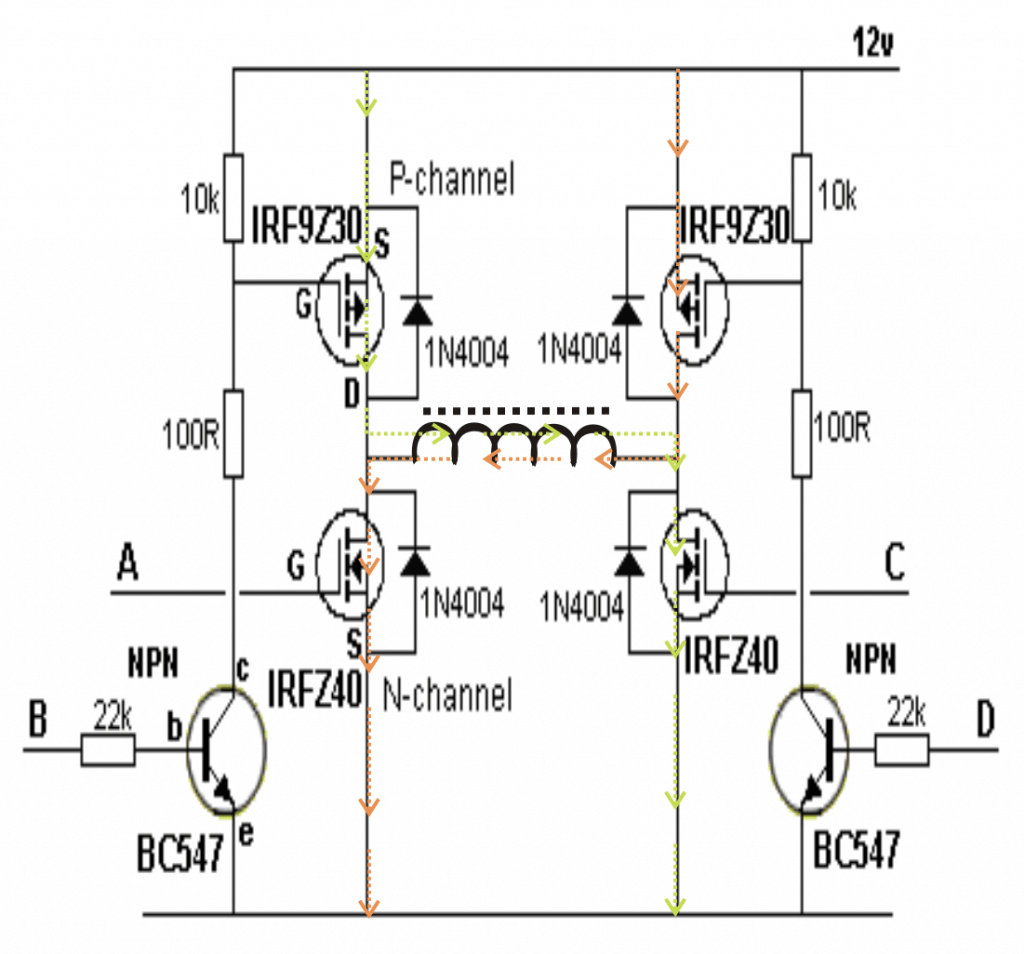
The above explanation provides the basic information regarding how to design an inverter, and may be incorporated only for designing a ordinary inverter circuits, typically the square wave types.
However there are many further concepts that may be associated with inverter designs like making a sine wave inverter, PWM based inverter, output controlled inverter, these are just additional stages which may be added in the above explained basic designs for implementing the said functions.
We will discuss them some other time or may be through your valuable comments.



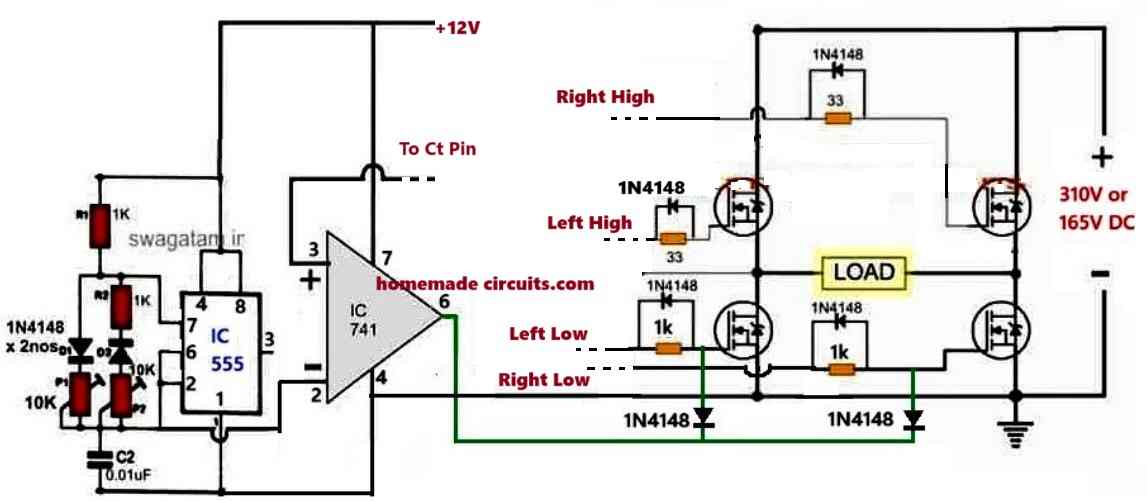
Comments
Commendable article. Impressively designed and narrated
Thank you! Glad you found it useful.
There is an engineering-level series on inverter design optimization in the newsletter at how2power.com It has 23 parts and has been running for over a year, with inverter design articles in nearly every issue.
OK, thanks, nice to talk to you, by the way, i’m from Tanzania, nice to meet you, thanks for replying my question
You are welcome fadhili…
hi dude, is a JT also classified as inverter..??? i was really wonder about JT, i’ve build ones to drive a 15W LED lamp (normally it’s 220Vac supply)…
i was sukses driving this 15w led using a JT (using 12v dry cell as supply) but the Transistor (C5192) was very hot… have any idea to cool it down without using fan..???
Sorry, I have never heard of JT, so not sure what exactly it is and how it may be related to an inverter? You can keep the transistor cool by replacing the transistor with higher rated one and by attaching a large heatsink to it. You can try using a TIP122 transistor
really don’t know about JT, Joule-thief, a simple blocking oscillators.. just type “JT” in google search box and you ‘ll find the result
NO, searching JT in Google does not produce the result Joule-thief.
You could have simply mentioned Joule-thief instead of writing JT.
ooopppsss… OK dude, it’s my bad…. bact to the main question, is Joule-Thief classified as an inverter too.. and how to make the transistor cooler, instead having a bulky heatsink nor using fan, i’m install it in my motorcycle as a lighting, so the bulk heat-sink is the problem it self…
Joule Thief is not an inverter. It is a simple voltage booster or step-up converter circuit that can efficiently drive a load using a low-voltage power source, such as a single-cell battery. The primary purpose of the Joule Thief is to extract the remaining energy from a nearly depleted battery that would otherwise be considered unusable.
You can try a bigger transistor such as a TIP35, if it still heats up then there’s no other alternative but to use a heatsink.
thank’s dude, i was done attached a heatsink in my circuit at first, the transistor gone heated-up ’cause i decrease the bias resistor, when i use 1K the transistor stay cool (Vout = 97Vdc), but the light seem too dim… then i decrease the R to 330 ohm, the light seems brighter (Vout = 125Vdc) but the Tr goes to heat,..this is the problem,..
i was wonder how the ideal value for Rb and the ideal Np/Nf for the inductor,.. may with the ideal value for both the led still bright, but the transistor stay cool…
NB :
Np = Turn of Primary winding
Nf = Turn of Feedback winding
Rb = value of Bias Resistor
The transistor is getting hot because it is being driven with overload and over current. I have suggested you the transistor number in my previous comment, you can use that to keep the transistor cooler.
OK, thanks man, nice to talk to you, by the way, i’m from indonesian, nice to meet you, thanks for replying my question,
No problem Dwi, Glad to talk to you. Let me know if you have more questions.
What is the best material that can be used for the outer casing of the invertor
Aluminum.
A group of us, in a third world country Nigeria, got together, bought components and had a technician put it together to give a 3.5kva inverter that functions perfectly.
We now wish to incorporate a remote monitoring and control system to be able to remotely switch on and off as well as monitor data from the system so as to ensure optimal operation at all times.
Neither we the owners, nor our technician knows how to go about it.
Kindly assist.
Hello, that might require too many complex circuits and networks, moreover the range will not be more than 50 meters.
How do I repair an inverter with output short-circuited?
If the output was shorted then probably the mosfets are blown….you will have to check the mosfets
How do i repair an inverter which will not power on but the fuse and power button are good
You must check whether the output wires are broken or not or whether the inverter is switching ON or not using the battery power.
Hi, thanks for coming up with this site, it has helped me alot in some projects.
Please I am trying to build 1kva inverter, can you guild me please?
Thanks
Hi, 1 kva inverter will require a 36V or 48V battery….you can refer to the following design, and try building it:
1500 watt PWM Sinewave Inverter Circuit
Hello sir, am a hobbyist and also a student in this descipline sir, I wanted to build an inverter using an old 2000watts stabilizer transformer core, I have been watching some YouTube videos on how to obtain the required parameters needed like TPV, SWG and Number of MOSFET to use supposed I want to build a 1kva inverter.
Please sir how do get all that from the transformer core size or Bobbin core area? Looking forward to your response sir thank you
Hello Aliyu, you will need a center tap transformer such as 12-0-12V or 9-0-9V, for a 12V powered inverter. You will have to check the existing transformer whether such a winding is available or not. If it is available then you can use it for making an inverter.
Pls sir, what kind of oscillator stage is used with either full or half bridge
Square wave and sine wave oscillators are used for making all types inverters.
Thanks for a wonderful explanation here
Thanks, glad you liked it!
I once drove an inductive load with an inverter. Turning off the load broke the inverter. However, I cannot find where the circuit failed. Where would you expect an inverter to fail under an inductive load?
Mostly it could be the power devices (MOSFETs, IGBTs) that might have burned, so you can isolate the power devices from the main circuit and check if they are OK or blown.
Good day sir, please I have this smiley su-kam 1.4KVa inverter showing high voltage output @ 280v. Even on load the voltage is still 280v. It’s burned about 3 incandescent bulbs already, I tried varying the two potentiometer on the PCB, no change was noticed, I even went ahead to change the PT but all still the same. What is the possible cause and solution to it sir. Thanks.
Hi Shankar, it seems the feedback control system is not working correctly, or malfunctioning. You will have to identify how the feedback system is configured from the AC output to one of the the IC input pins, and then troubleshoot why this feedback is not working for the output voltage correction
Hello please am new to electronics and i want to build, a pure sine wave inverter, any help from anybody here please.
thank you
Thank you sir for your impact.
Please sir I need 1000watt inverter circuit
Eben, you can try the following one
500 Watt Inverter Circuit with Battery Charger:
Use two MOSFETs in parallel on each channel
Battery must be 500 Ah minimum
please, i want the equation which using for design inverter
Hi Nimai, if you use 12V to make 3000 W inverter then the current for the transformer will be 3000/12 = 250 Ampere….such a transformer looks unpractical, and unfeasible, therefore you must use a 48V battery, instead of 12V battery
Hi Swagatam
I am trying to make 12 v to 230vac
2000w and 3000w
Please send, simple circuit,
Transformer details
12V/200 watt inverter will require a 166 amp transformer, and a 1000 Ah battery, is it possible to get them?
Hi
I m trying to make 12 v to 230vac
2000w
Please send, simple circuit,
Transformer details
Your inverter has problems, so you must troubleshoot them, that’s the only remedy…
your transformer, battery, are oK…verify the MOSFeTs and the frequency of the oscillator
What can I do to remedy the voltage drop
Whether it is a single 24V or two 12 in series, the effect will be the same.
Sir what of if I connect two 12v battery in series to get 24v will the circuit work fine.
The power rating are quite substantial so 60 watt load shouldn’t have caused any drop. The transformer primary voltage should be slightly less than the battery voltage, so make sure this is also followed.
1000watt transformer with an input voltage of 220v and output of 24v then the battery is just 72Ah.
Please provide the wattage of the transformer and Ah value of the battery?